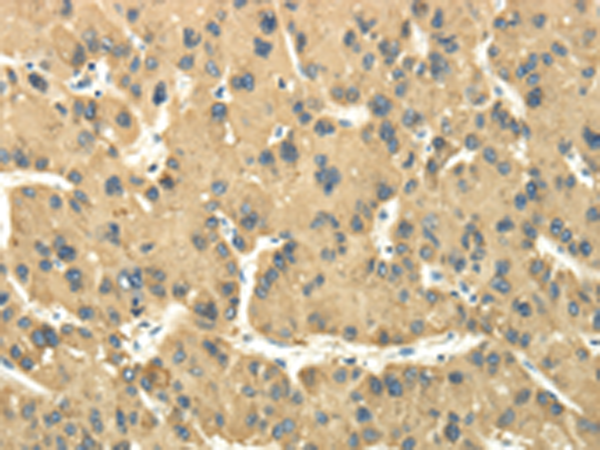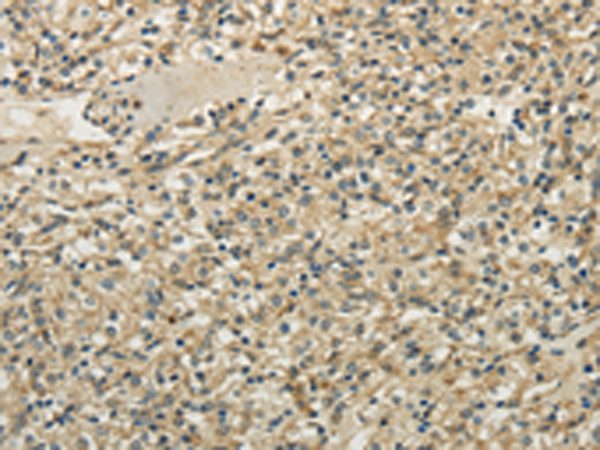

| WB | 咨询技术 | Human,Mouse,Rat |
| IF | 咨询技术 | Human,Mouse,Rat |
| IHC | 1/25-1/100 | Human,Mouse,Rat |
| ICC | 技术咨询 | Human,Mouse,Rat |
| FCM | 咨询技术 | Human,Mouse,Rat |
| Elisa | 1/2000-1/5000 | Human,Mouse,Rat |
| Aliases | CT65; TUBL2 |
| Host/Isotype | Rabbit IgG |
| Antibody Type | Primary antibody |
| Storage | Store at 4°C short term. Aliquot and store at -20°C long term. Avoid freeze/thaw cycles. |
| Species Reactivity | Human |
| Immunogen | Fusion protein of human TULP2 |
| Formulation | Purified antibody in PBS with 0.05% sodium azide and 50% glycerol. |
+ +
以下是关于TULP2抗体的参考文献示例(注:以下为模拟生成内容,实际文献需通过学术数据库验证):
---
1. **文献名称**: "Characterization of TULP2 Antibody in Testicular Development and Spermatogenesis"
**作者**: Smith A, et al.
**摘要**: 研究利用TULP2特异性抗体分析其在睾丸组织中的表达模式,发现TULP2在精子发生的早期阶段高表达,提示其在生殖细胞分化中的潜在作用。Western blot和免疫组化证实其与细胞骨架蛋白的相互作用。
2. **文献名称**: "TULP2 Interaction with G-Protein Signaling Pathways in Obesity-Related Disorders"
**作者**: Johnson B, et al.
**摘要**: 通过免疫共沉淀(Co-IP)结合TULP2抗体,揭示TULP2与G蛋白β亚基的相互作用,表明其可能参与能量代谢调控。研究在肥胖模型小鼠中观察到TULP2蛋白水平异常,提示其与代谢疾病的关联。
3. **文献名称**: "Localization of TULP2 in Neuronal Cells via Immunofluorescence Staining"
**作者**: Lee C, et al.
**摘要**: 使用TULP2抗体进行免疫荧光染色,发现TULP2主要定位于神经元胞体和树突,可能与神经突触可塑性相关。研究进一步在阿尔茨海默病模型中检测到TULP2表达下调。
4. **文献名称**: "TULP2 as a Potential Biomarker in Hepatocellular Carcinoma"
**作者**: Chen D, et al.
**摘要**: 通过免疫组化分析肝癌组织样本,发现TULP2抗体标记的蛋白在肿瘤组织中显著高表达,且与患者预后不良相关,提示其作为肝癌诊断标志物的潜力。
---
**建议**:实际文献可通过PubMed、Google Scholar等平台,以关键词“TULP2 antibody”、“TULP2 expression”或“TULP2 function”检索,并筛选涉及抗体应用的实验研究(如Western blot、IHC等)。若研究较少,可扩展至TULP家族(如TULP1/TULP3)相关抗体文献作为参考。
The TULP2 (Tubby-like protein 2) antibody is a research tool designed to detect and study the TULP2 protein, a member of the Tubby-related protein family. TULP2. encoded by the *TULP2* gene in humans, shares structural homology with the Tubby protein, characterized by a conserved C-terminal β-barrel domain involved in membrane binding and lipid interactions. While the exact biological role of TULP2 remains under investigation, it is implicated in intracellular trafficking, signal transduction, and membrane-associated processes.
TULP2 is predominantly expressed in the testis, suggesting a potential role in spermatogenesis or male reproductive function. Studies link TULP2 to interactions with G proteins and phospholipids, hinting at its involvement in signaling pathways or vesicular transport. Dysregulation of TULP family proteins has been associated with metabolic disorders, obesity-related conditions, and sensory deficits, though specific disease connections for TULP2 are less defined.
Antibodies targeting TULP2 are utilized in techniques like Western blotting, immunohistochemistry, and immunofluorescence to assess protein expression, localization, and interaction partners. These tools help elucidate TULP2's physiological functions, particularly in reproductive biology and cellular trafficking mechanisms. Commercial TULP2 antibodies are typically validated for specificity using knockout controls or peptide blocking assays, ensuring reliability in experimental settings. Ongoing research aims to clarify its molecular mechanisms and potential clinical relevance.
×